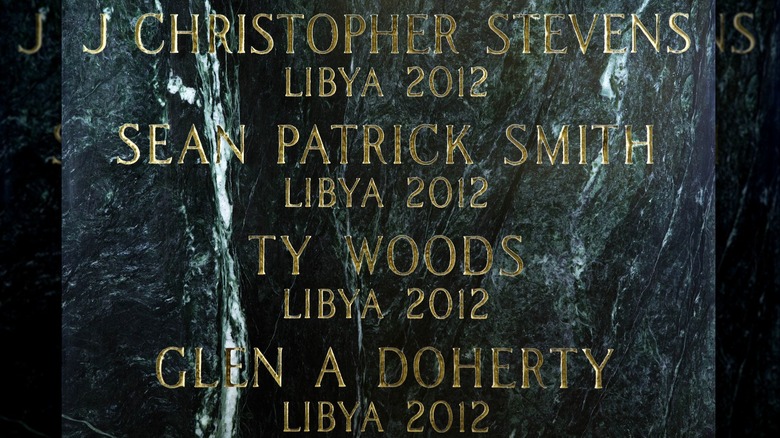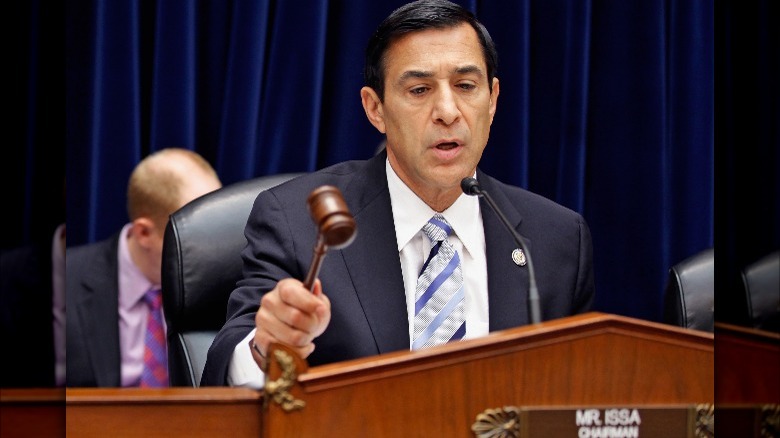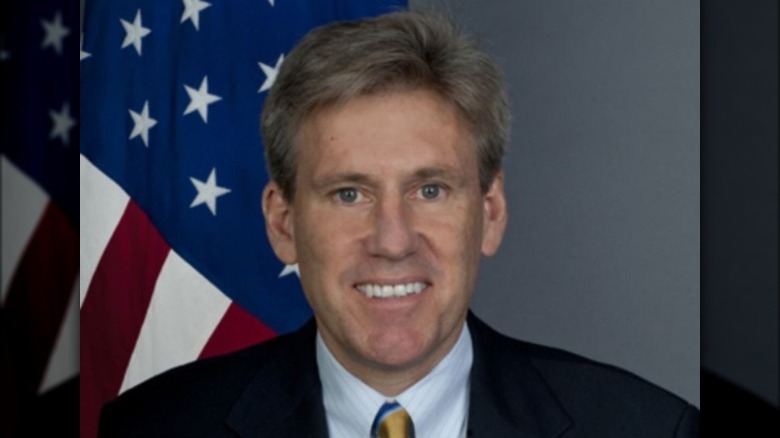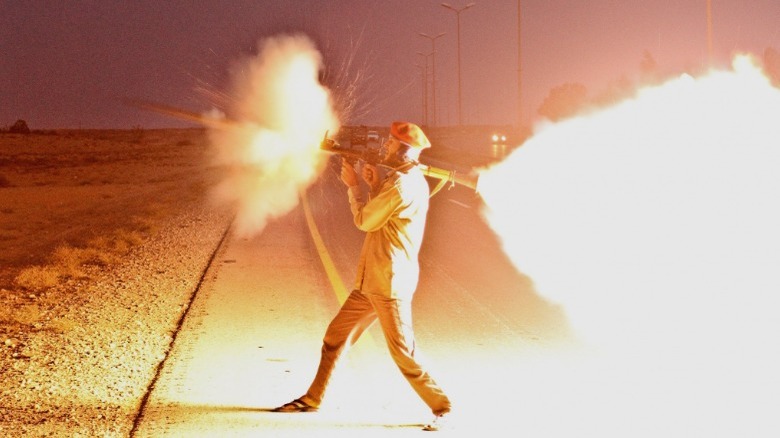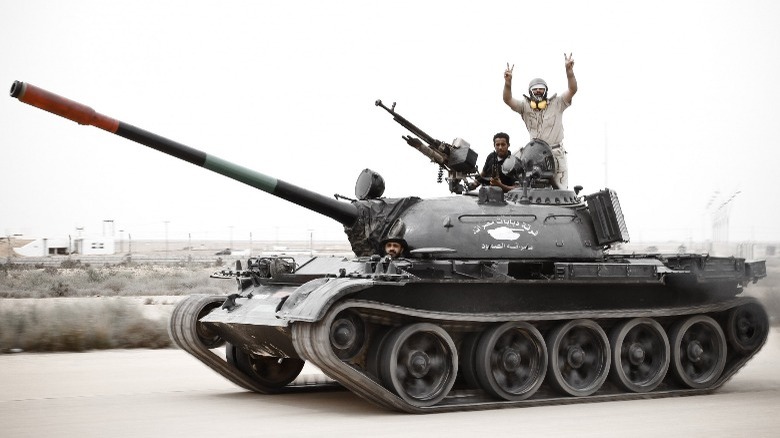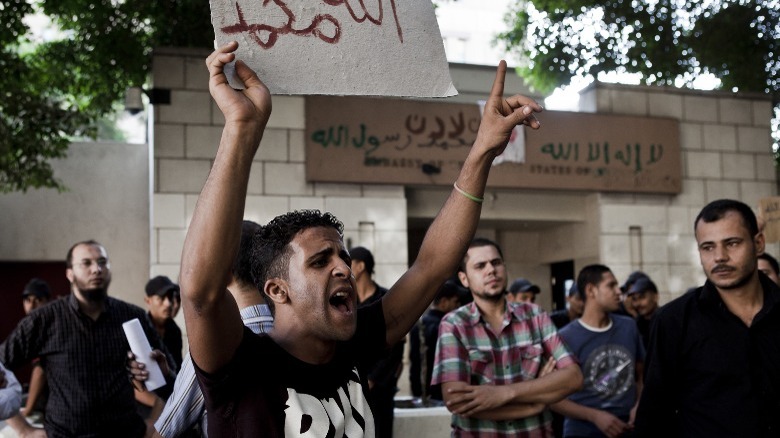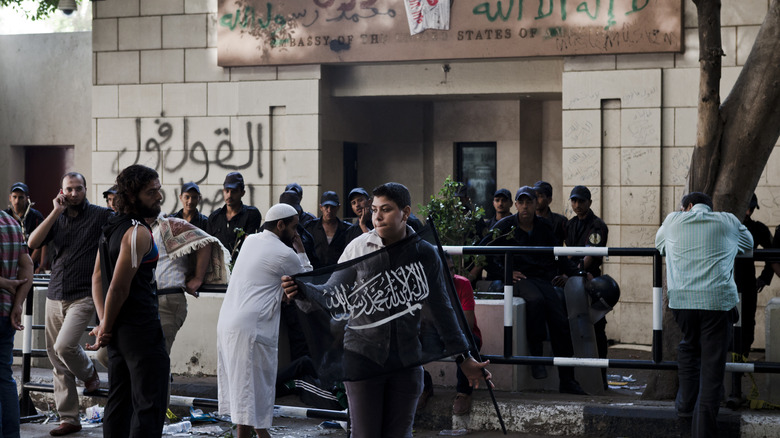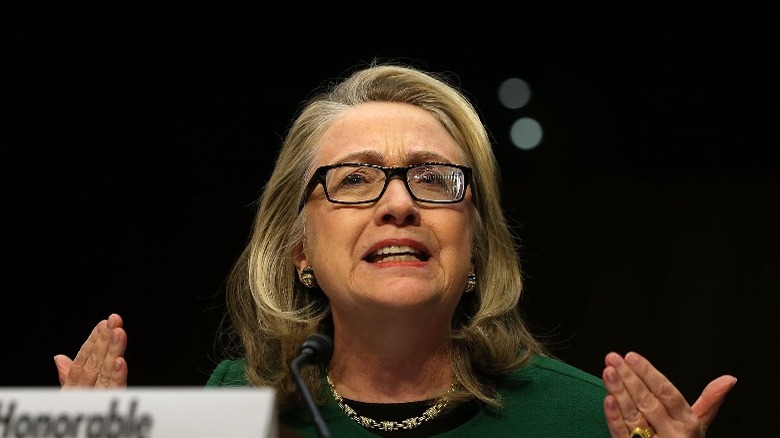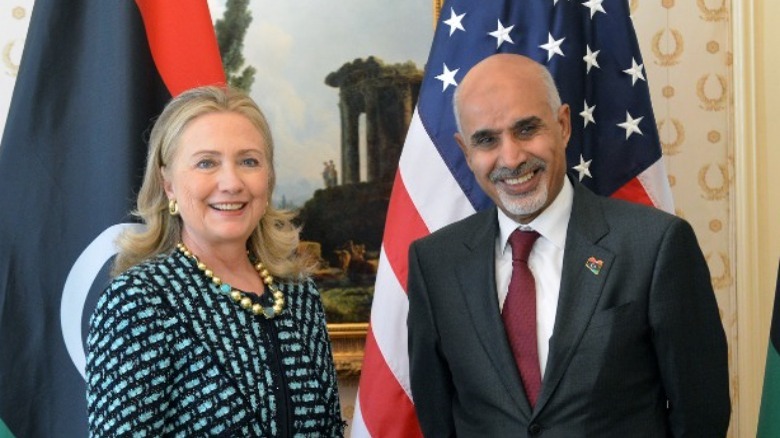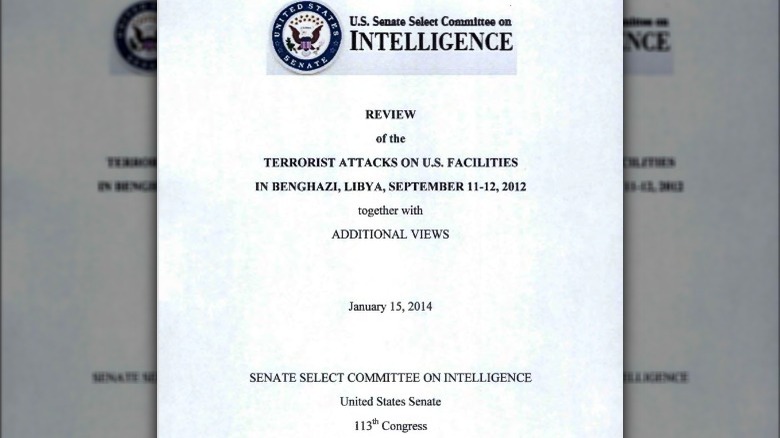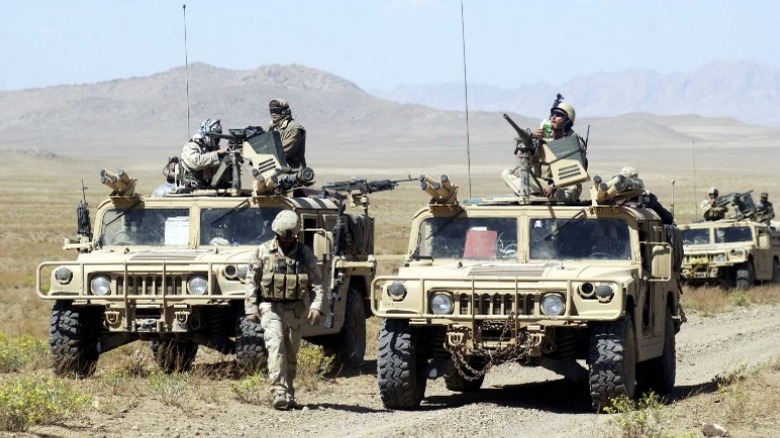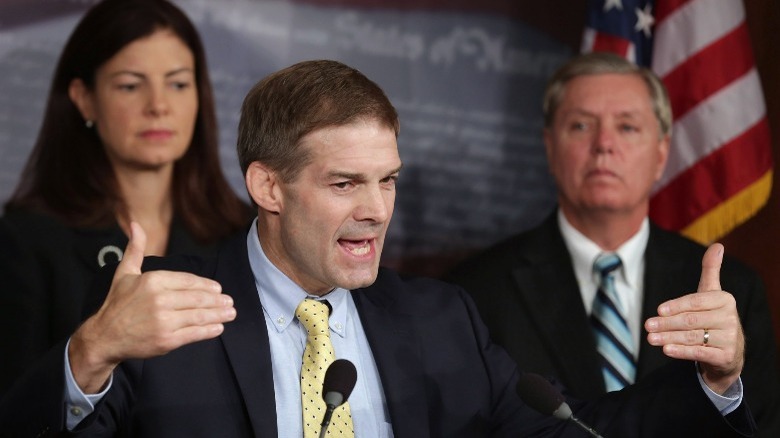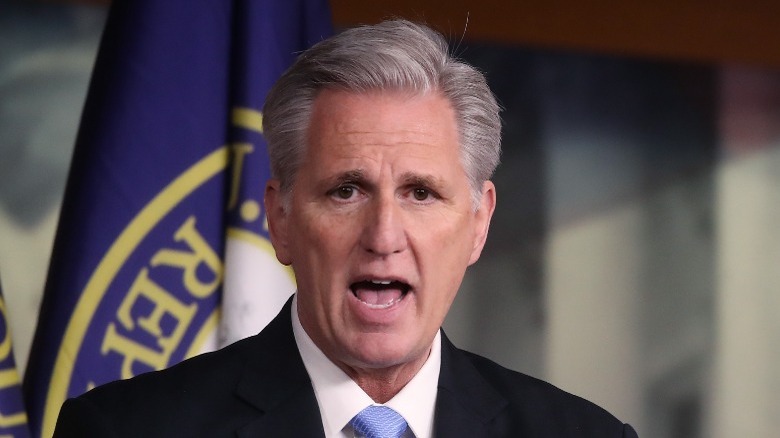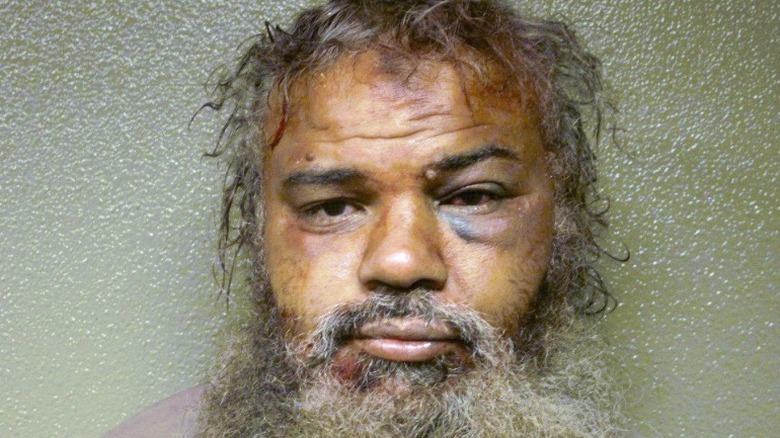The Messed Up Truth Of 2012's Benghazi Attack
In 2012, on the 11th anniversary of the 9/11 terrorist attacks, an armed mob stormed the United States Consulate in Benghazi, Libya, killing four Americans and setting the compound on fire. The attackers were a mix of the terrorist group Ansar al-Sharia and several northern African and Arabian offshoots of al-Qaeda (per the Senate Select Committee on Intelligence's Report). Immediately, reports flashed across American news channels like CNN and Fox News alerting Americans to the horrors going on in Libya. The four Americans who died in the Benghazi attacks were U.S. Ambassador to Libya J. Christopher Stevens, Foreign Service Officer Sean Smith, and two CIA contractors, Tyrone S. Woods and Glen Doherty.
The Obama Administration immediately condemned the attacks, and a series of inquiries quickly began. In the decade since, several federal investigations have taken place looking into the attack and the response from U.S. officials. The attacks, and subsequent investigations, became flashpoints of the ongoing 2012 presidential election and caused bitter partisan feuds to erupt in both chambers of the U.S. Congress. Now, nearly a decade later, the ghosts of Benghazi still haunt American politics. This is the messed up truth of 2012's Benghazi attacks.
The U.S. mission in Libya asked for more security before the attack
In the six months leading up to the attacks at Benghazi, the U.S. mission in Libya repeatedly asked officials in Washington for increased security measures. The mission requested the measures due to several violent incidents involving western diplomats and officials, and because numerous firefights and explosions had gone off within close proximity to the U.S. consulate.
A letter from Rep. Darrell Issa, chairman of the Committee on Oversight and Government Reform, and Rep. Jason Chaffetz, chairman of the Subcommittee on National Security, Homeland Defense, and Foreign operations, to Secretary of State Hillary Clinton, detailed some of the incidents. In April, a fistfight turned into a firefight, and a local Libyan militia had to evacuate a U.S. Foreign Service officer to safety. A month later, multiple RPG rounds exploded at the International Red Cross office just over a mile from the U.S. consulate. In early June, an IED blew up at the consulate gate, and militants fired an RPG at a British ambassador's car. Disturbingly, in early September, rumors floated among local Libyan guards about an impending attack.
Just after the attacks, NPR reported that in the days prior to the attacks, Libyan militia leaders met with U.S. officials over the rapidly destabilizing security situation. One militia leader reportedly said that he warned U.S. officials during a meeting of increased assassinations and the lack of safety, but they did not heed his messages.
Two American diplomats died of smoke inhalation
At a press conference in October, senior State Department officials detailed the turbulent attack on the U.S. compound. The attack began at 9:40 p.m., and security agents immediately heard chanting and saw large numbers of armed men streaming through the entrance into the compound. Immediately, U.S. Ambassador to Libya J. Christopher Stevens, Foreign Service Officer Sean Smith, and another security agent fortified themselves inside a safe-haven in one of the buildings. Attackers quickly penetrated the building, and when they could not locate the Americans they set it on fire. The fire swiftly engulfed the building and choked the air with smoke, forcing the three of them to decide on an escape plan. In the commotion, the security agent lost track of both Stevens and Smith.
At this point, security team members from a nearby compound, along with their Libyan allies, the February 17th Martyrs Brigade, headed to the compound to rescue the remaining agents. Multiple teams of agents fought in firefights with various groups of attackers, and miraculously, no other security agents lost their lives in the ensuing battles. The team managed to secure Smith's deceased corpse, but they were unable to find Stevens. It was later determined that both Smith and Stevens had died from smoke inhalation from the fire and were not shot by attackers (per the Final Report from the House Select Committee).
The terrorists then attacked the CIA annex after the team fled there
According to the House Select Committee, while the security team was still searching for Ambassador Christopher Stevens, the attackers launched a second wave of assaults following an explosion at the back gate. The team, with Sean Smith's body in tow, fled the compound and headed towards the CIA annex located in another U.S. compound a few blocks away. They immediately hit roadblocks and armed attackers who open fired on their reinforced vehicles. Facing rapid ak-47 gunfire and constant grenade explosions, the team hastily made their way to the annex where they arrived to stunned friendly forces.
Per the Report, an hour after arriving at the annex attackers launched a new attack with small arms and IEDs. After this attack was put down, the terrorists began another that involved heavier firepower, including RPGs, but the security successfully repelled this attack too. At 5:05 a.m. the rescue force arrived at the annex from the Libyan airport. Attackers immediately attempted another assault on the annex using small arms fire, but the attack quickly accelerated when they started launching mortars at the annex. The mortars killed Tyrone S. Woods and Glen Doherty, both former Navy SEALs who were working for the CIA at the time (per UPI). Finally, the report notes the entire group fled to the Libyan Airport for evacuation, with another CIA officer destroying the remaining sensitive equipment before fleeing the annex.
Former Qaddafi Military officers actually helped U.S. forces
In a surprising turn of events, it turned out that several local Libyan forces assisted U.S. personnel on the ground multiple times during the attacks. The House Select Committee's Final Report states that just after the security team fled the compound, local Libyans found Ambassador Christopher Stevens' body. They reported it to a nearby Libyan army officer, who took Stevens' cell phone and frantically started dialing numbers listed in the phone hoping to find someone. Eventually, the officer took him to the hospital where it was determined he had died. His body was given to Americans later that morning.
The Libyan Military Intelligence (LMI) forces also provided direct assistance to the Americans at the CIA annex. Per the Report, during the mortar assault at the annex, a CIA officer got in touch with a colonel from the LMI. The LMI, it turned out, was not associated with the Libyan government. Instead it was a group composed of officers who had served under the previous Qaddafi regime, the same regime NATO helped oust during the Libyan Revolution. The LMI showed up with 50 armored trucks that led U.S. forces safely to the airport. As the report put it, "some of the very individuals the United States had helped remove from power ... were the only Libyans that came to the assistance of the United States on the night of the Benghazi attacks."
Protestors swarmed the U.S. embassy in Cairo over controversial movie
In early July 2012, just months before the Benghazi attack, a shadowy figure under the alias Sam Bacile posted a trailer for his feature-length film, "Innocence of Muslims," to his YouTube channel (per NPR). The trailer caused outrage in the Muslim world as it portrayed the prophet Muhammad in incredibly insensitive and blasphemous ways. Within a few days it emerged that Bacile was just an alias for Nakoula Basseley Nakoula, a Coptic Christian and Egyptian-American. According to ABC, Nakoula admitted to writing, producing, and directing the film. Nakoula, 55, was living in Cerritos, California, and had previously been imprisoned multiple times for manufacturing methamphetamine and bank fraud. He reportedly lied to the cast and crew about the true nature and meaning of the film and had most of the cast's lines overdubbed in post-production to say inflammatory anti-Muslim lines.
The New York Times reported that thousands of protestors gathered outside the U.S. Embassy in Cairo in response to the film on September 11. Some of the protestors even breached the embassy walls, where they destroyed a U.S. flag and replaced it with a black Islamic flag. Guards fired their weapons into the air but did not use further force against the crowd as the protests remained largely peaceful. U.S. officials would conflate these protests in the weeks following the attack in Benghazi.
The Cairo protests were wrongly connected to the attacks
In the immediate aftermath, the Obama Administration struggled to keep a coherent narrative about the cause of the attack. In his initial remarks the morning after the attacks, President Barack Obama seemed to connect "Innocence of Muslims" with the Benghazi attack. He admonished efforts to besmirch other religions, and he called the attack an act of terror. During a town hall event a week later, he gave a similar impression when he said extremists used videos that insensitively depicted Muhammad as a pretext to attack Westerners.
In an interview with ABC on September 15, U.S. Ambassador to the U.N., Susan Rice, directly connected the "Innocence of Muslim" video and Cairo protests with the Benghazi attack. She claimed the attack devolved into violence after extremists took over an ongoing protest at the consulate that was in response to those in Cairo.
It was not until September 28, over two weeks after the president's initial statements, that the administration changed their assessment. In a statement on behalf of the Office of the Director of National Intelligence, director of Public Affairs Shawn Turner said the ODNI's analysis of the intelligence had matured, and they were modifying their initial judgments. He stated they no longer thought the attack was related to the protests and called it a "deliberate and organized attack carried out by extremists."
Secretary of State Hillary Clinton was at odds with the State Department
Like the White House, Hillary Clinton initially connected the protests against the "Innocence of Muslims" trailer with the attack in Benghazi. In her initial press release, she said some people wanted to defend the attacks in Libya and protests in Egypt as responses to the film. Almost a week later, Clinton made further remarks refuting that they had any prior knowledge of a preplanned attack in Benghazi.
However, from their first briefing, State Department officials refused to acknowledge an explicit link between the Cairo protests and the Benghazi attack. A reporter directly connected protests in Benghazi with the attacks, and the official seemed confused and suggested they were unclear on the events immediately preceding the attack. Within days of the attack, CNN reported that State Department officials told them the protests in Cairo and the Benghazi attack were not related.
It was not until a month later, in mid-October, that Clinton reversed herself during an interview with CNN. When asked about the changing story from initial statements that protests transformed into the attack, to later statements that the attack was premeditated and planned out, Clinton conceded she had been wrong initially. She said the intelligence had adjusted from initial reports and denied there was any cover-up.
The Libyan President publicly disagreed with the Obama Administration
In an exclusive interview with NPR just days after the attack, Libyan President Mohammed el-Magariaf emphatically denied any link between protests and the deadly attack. He said that in the months prior, Algerians and Malians had illegally entered the country from the west by taking advantage of the deteriorating security situation. He claimed he had evidence that showed the foreign Algerian and Malians had used the eastern Benghazi extremist group "Ansar al-Sharia" to attack the U.S. consulate. Magariaf called the idea that the "Innocence of Muslims" trailer and attack were related ridiculous and lacking evidence. The attacks, he said, were premeditated and did not arise spontaneously from the protests.
However, Magariaf did suggest that the attackers used protests outside the consulate in Benghazi as cover to carry out their operation. The protestors and the attackers were different groups, according to Magariaf, and he called the incident uncivilized. A few days earlier, NPR also reported that Libyan Deputy Interior Minister Wanis al-Sharef suggested the attacks were possibly coordinated with the anniversary of 9/11, and he claimed the attackers used civilian protestors as a mask for their operation.
Evidence revealed there was no protest activity in Benghazi
Though several members of the Obama Administration suggested a clear link between the "Innocence of Muslims" protests and the attacks in Benghazi, within weeks reports emerged contradicting this. Just two days after the attack, NPR was already reporting eyewitness accounts that there were no protests outside the Benghazi compound prior to the attack. In a briefing in early October, State Department officials said the compound was peaceful just an hour before the attack started, and that nothing had seemed out of the ordinary.
In the Senate Select Committee on Intelligence's 2014 review of the Benghazi attacks, they definitively concluded there had been no protests at the compound prior to the assault. The report blamed a lack of reliable eyewitnesses and intelligence sources on the ground for the inaccurate characterization of the protests. In addition, the report noted the assessment on Benghazi, though flawed, was made in the midst of roughly 40 separate but simultaneous protests against U.S. embassies worldwide, including in Egypt, Tunisia, and Yemen. The reports notes those protests were in direct response to the film and thus were not preplanned attacks like Benghazi.
The terrorists have been linked to al-Qaeda
Initial reporting linked the attack to groups affiliated with the infamous terrorist organization al-Qaeda, who were responsible for the 9/11 terrorist attacks in New York City. In his interview with NPR, Libyan President Mohammed el-Magariaf immediately labeled al-Qaeda as potentially involved in planning the assault, saying they used illegal foreign immigrants as conduits. In her remarks at the UN in late September, Secretary of State Hillary Clinton also seemingly drew a link between the groups affiliated with al-Qaeda and the attack at Benghazi.
The House Select Committee's Final Report and the Senate Select Committee on Intelligence both cited several groups affiliated with al-Qaeda as participants in the attack. These groups included al-Qaeda in the Lands of the Islamic Maghreb, al-Qaeda in the Arabian Peninsula, al-Qaeda in Iraq, as well as multiple other groups not explicitly financed by them. According to the reports, these groups had worked to establish a presence in the city in the months prior to the attack. In addition, most reports have speculated that the timing of the event for September 11 was specifically planned.
Partisanship got very extreme
A few months after the attacks, Republicans accused the Obama Administration of lying during a heated meeting of the House Foreign Affairs Committee. Republican Rep. Dana Rohrabacher claimed the Obama Administration had "intentionally misinformed, read that LIED, to the American people" (per NBC). Republican Rep. Jean Schmidt accused the administration of saying things that were false. In response, Democratic Rep. Gary Ackerman decried the insincerity and dishonesty in the room, and Democratic Rep. Gerald Connolly called the Republican tactics "McCarthyism."
The partisanship got so extreme, that in 2016, the final House Select Committee on Benghazi released two separate final reports, one from the Democrats and one from the Republicans. Naturally, they came to differing conclusions. The Democrats' released their report first, and it included a section titled "Select Committee Squandered Millions of Dollars in a Partisan Effort to Attack a Presidential Candidate." They suggested the entire probe was in place just to smear Hillary Clinton's presidential campaign and argued they compromised their integrity with their actions.
In their report, House reps. Jim Jordan and Mike Pompeo included their own section addressing their specific views on the attacks. In their section, they claimed the Obama Administration misinformed the public about the incident and refused to cooperate with investigators.
Ten separate investigations were launched but none found the Obama Administration at fault
In the four years following the attacks, no less than 10 separate investigations were launched trying to uncover what happened. According to CBS, the day after the attacks the FBI launched an investigation into the incident. The House committees on Armed Services, Foreign Affairs, the Judiciary, Oversight and Government Reform, and the Permanent Committee on Intelligence, all began simultaneous investigations into what happened.
The deaths of U.S. personnel at a. U.S mission abroad also necessitated the creation of a State Department Accountability Review Board investigation (per the Federal Register). In 2012, the Senate Committee on Homeland Security and Government Affairs released their report, and in 2014 the Senate Select Committee on Intelligence released their report. In 2016, the House Select Committee on Benghazi released its dueling reports, which as to date are the most recent federal/congressional investigations to have occurred.
In none of the investigations was it ever determined that any member of the Obama Administration deliberately lied or committed any crimes during the incident or its aftermath. Several of the reports criticized the administration for security lapses, poor judgment, and negligence, but all stopped short of suggesting criminal or deliberate intent
One of the terrorists was found not guilty of murder
Almost a decade after the attacks, only two individuals have been brought to justice by the U.S., and both cases ended in disappointment. It wasn't until June 2014 that U.S. commandos captured their first suspect, Abu Khattala, a Libyan and leader of Ansar al-Sharia (per the Washington Post). A dozen other suspects had been charged in connection with the attack, but Khattala was the first to be apprehended. In October 2017, ABC reported that U.S. Special Forces had captured a second suspect, Mustafa al-Imam. Both suspects were charged with numerous counts relating to terrorism and murder.
Shockingly, neither Khattala nor Imam were convicted of any murder charges or given the death penalty for their role in the attack. However, both were convicted of charges related to terrorism. In 2018, the New York Times reported that the judge sentenced Khattala to 22 years. According to the Times, the judge argued Khattala "was essentially convicted of property crimes" that did not merit an execution. Imam was sentenced to 19 years in prison in January 2020 (per the Department of Justice).
The aftermath of Benghazi meant many things for America. It shocked the American people and the press, led to years of bitter partisan warfare, and produced a double-digit number of investigations that only seemed to spin their wheels in mud.
